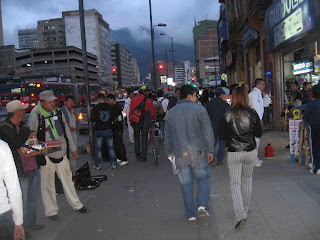 |
| Bad guys! Cyclists not using a Cicloruta. |
Are Bogotá's
famed Ciclorutas - one of the prides of the cycling community - being turned into a
liability for Bogotá's cyclists?
That's what it sounds like from this Sunday's
opinion column in El Tiempo by Carlos Felipe Pardo. Pardo says that several cyclists have reported being stopped, ticketed and fined for riding on streets that lacked ciclorutas but were within five kilometers of a Cicloruta.
Carlos Felipe Pardo is a clearheaded supporter of cycling and sustainable transport who's worked for several international transit agencies. That's why one's got to take his concerns seriously, as bizarre as this one sounds.
 |
| There's a Cicloruta here - can you see it? |
If this has really become city policy (based on no law that I know of), then it's a great formula for eliminating cycling in the city. As impressive as Bogotá's Ciclorutas are compared to those in the rest of Latin America, they lead only to a limited number of places. And many are in deplorable shape, damaged by potholes and obstructed by pedestrians and delivery vehicles. Anyone who expects cyclists to ride five kilometers out of their way to find a cicloruta and then five more kilometers back to find their original destination, is living in a different reality. It suggests a terrible double standard - when car drivers don't hesitate to lean on their horns because of two-second delays and routinely park on sidewalks.
 |
| Will your wheels survive this Cicloruta? |
Such a policy - if real - also seems based on a belief that cyclists are delicate creatures unfit to venture near motorized vehicles. And that cyclists are neither important themselves nor headed anywhere important enough to be in a hurry to get there.
Certainly bicyclists, balanced on two wheels without a steel shell surrounding them, are much more vulnerable than car drivers. But all over the world cyclists can and do share roads and highways with motor vehicles. And it's the motor vehicle drivers' responsibility to respect cyclists, not cyclists' responsibility to clear out of their way - particularly in a city in which drivers routinely invade pedestrians' space in crosswalks and on sidewalks.
Another message is that bicycles aren't practical transportation vehicles, but should be restricted to Ciclorutas, sidewalks and public parks - even tho at least one important Bogotá public park prohibits bicycles, for reasons which completely escape me (and probably the park authorities as well).
Restricting cyclists' rights is no way to improve traffic safety. And, as Pardo predicts, many frustrated cyclists will likely buy motorcycles - which are notoriously dangerous as well as polluting.

